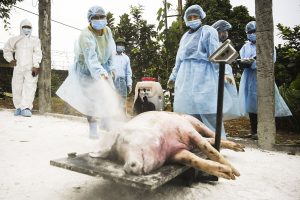
Here in California we are still under lockdown or shelter-in-place orders, as are most people throughout the United States. As a result of COVID-19, there is a noticeable shift in shopping behavior as we consume more “comfort foods” and keep our homes and clothing cleaner than ever. Frozen pizza, pasta sauce and good old mac and cheese along with frozen vegetables, prepared meals and Hot Pockets are all performing well at retail level. Campbell Soup Company said retailers are buying more canned soups and SpaghettiOs.

Many Americans are now eating three meals a day at home as dining out has become a thing of the past. Some continue to order take-out from the restaurants (the ones that are still open), but often the prices are just too high for those who are out of work or on fixed incomes. So, it looks like home cooking is back, but will it continue after the end of this pandemic? That remains to be seen, but in the meantime, people are stocking up on Knorr soup cubes, instant noodles and Hellman’s mayonnaise, to name a few.

One shift for sure is the move to shop online as consumers under lockdown opt to order everything and anything on the internet – they will continue to do so in the future. Many brick and mortar businesses have had to create online platforms quickly so that loyal customers can continue to purchase from them.
During this crisis, the noticeable shortages so far have been in paper products like toilet paper, paper towels, diapers and laundry detergent, bleach and so on. We haven’t really seen a shortage in proteins like meat or pork…but it looks like we may be heading that way.
“There just isn’t enough pork in the world to fill the gap.”

That’s what people said when the African Swine Flu hit China hard last year…because 40% of Chinese pigs – that’s millions and millions and millions of pigs were lost or euthanized. As a result, prices soared, and imports of U.S. pork increased along with product from Brazil, Ireland and other countries. And the ban on pork from Canada was lifted in November 2019 to help ease the problem.
However, good news came for Chinese pork lovers just this week when the Ministry of Agriculture and Rural Affairs announced that China’s hog production and sales recovered in March 2020 and the recent high prices were beginning to decline. It seems like a miracle but is due in part to the addition of 18,000 more pig farming businesses to the existing 370,000 farms already in operation. Increased efficiency from the large-scale standardized pig farms (which are quickly replacing many smaller, family-owned operations.) is helping as well.

Now here’s the thing: Chinese people love their pork and the average Chinese person eats about 30 kg of pork per year. And here in the USA we love our beef – consuming about 26 kg of beef a year. While our problems here are nothing of the magnitude of the recent swine fever pork crisis in China, we may soon be facing meat shortages due to COVID-19 plant closures.
The first indication came with the closure on April 12, 2020 of Smithfield’s meat processing facility in South Dakota due to a COVID-19 outbreak infecting more than 700 employees. Just two days later, Smithfield announced it was shutting down two additional meat processing facilities in Missouri and Wisconsin. Same problem in these locations.

By the way, Smithfield is 100% Chinese owned – purchased for 4.7 billion dollars in 2013 by Shaunghu International Holdings Ltd.) At that time, it was the largest amount paid for an American company – and they didn’t just buy an American business, they bought 25% of the U.S. pork industry.
The closure of the Smithfield plants was followed by the closure of JBS USA plant in Worthington, Minnesota. It employed 2,000 people and processed 20,000 hogs per day. And then on April 22, 2020, Tyson Foods announced it was closing its Waterloo, Iowa plant that employs 2,800 people and processes 19,500 hogs per day along with its beef processing facility in Pasco, Washington. Waterloo is Tyson’s largest pork processing plant and represents 4 percent of the nation’s pork processing capacity.
There is no doubt these and new shutdowns will lead to potential shortages and send pork and beef prices higher in the grocery stores. Hopefully we won’t see the hoarding and panic buying of meats that we experienced over the last two months for paper towels and toilet paper, but Americans do love their meat!
Lily Noon
Sources:
- Another Big Meat Plant Shutters – Bloomberg
- Meat Shortage Risk Climbs with 25% of U.S. Pork Capacity Offline – Yahoo Finance
- Fears of Meat Shortage are Rising – Forbes
- More Cooking, Less Shampooing: The Coronavirus Consumer Starts to Emerge
- Comfort Foods Make a Comeback in the Coronavirus Age
ここカリフォルニア州では、今もロックダウンで外出禁止が続いていますが、全米のほとんどが同じ状況です。新型コロナウイルス感染症(COVID-19)が拡大したのを受けて、買い物行動に明らかな変化が現れました。多くの消費者が、コンフォートフード、すなわち心が和むような食べ物を買い求めるようになっていて、室内や洋服を清潔に保つための商品も売れています。スーパーで売れ筋の食品と言えば、冷凍ピザ、パスタソース、昔ながらのマカロニ&チーズ、冷凍野菜、調理済み食品や「ホット・ポケッツ」のような電子レンジで温めるだけの手軽な軽食です。キャンベル・スープ・カンパニーによると、缶詰スープと缶詰パスタ「スパゲティ・オー」の売り上げが伸びたそうです。
今では多くのアメリカ人が自宅で三食食べていて、外食は過去のことになりました。今でも営業を続けているレストランからテイクアウトを注文している人もいますが、失業した人や年金受給者などにとっては、とにかく値段が高すぎます。というわけで、「家ごはん」が復活しました。でも、パンデミックが終息した後も、このトレンドは続くのでしょうか? その答えはまだ分かりませんが、その間にも消費者は、クノールの固形スープやインスタント麺、ヘルマンのマヨネーズなど、なじみ深いブランドの食品を買い込んでいます。
ひとつ明らかな変化と言えば、オンラインショッピングの増加です。ロックダウン中の消費者が、あらゆるものをオンラインで購入し始めましたが、これは今後も続くでしょう。実店舗の小売店は、すばやくオンラインのプラットフォームを開設する必要がありました。これまでの固定客を失わないようにするためです。
この危機の間に品薄が顕著なものは、トイレットペーパー、ペーパータオル、紙おむつなどの紙製品、それに洗濯洗剤や漂白剤などです。今のところ、牛肉や豚肉などのタンパク質類はあまり不足していませんが、今後は供給が逼迫する可能性があります。
「世界中の豚肉を集めても、需要に応えられない」
昨年、アフリカ豚熱が中国の養豚産業に壊滅的な打撃を与えたとき、関係者はこう語りました。中国の家畜ブタの40%に相当する数億頭が、死亡または殺処分されたためです。この結果、価格が高騰し、米国をはじめ、ブラジル、アイルランドといった国からの輸入豚肉が中国に流れ込みました。また、この問題を緩和するため、カナダ産の豚肉に課されていた輸入禁止措置も2019年11月に解除されました。
とはいえ、豚肉好きな中国の人々にとって朗報が今週ありました。中国の豚肉生産量および販売量が2020年3月時点で回復し、価格が下がり始めたと、中国の農業農村部が発表したのです。奇跡のように聞こえるかもしれませんが、その背後には、既存の37万件の養豚場に加え、新たに1万8,000件の養豚場が追加されたことが、一因としてありました。標準化された大規模な養豚場が家族経営の小規模な養豚場に取って代わりつつあり、業務効率が高まっていることも、この状況改善に寄与しています。
ただし、重要な点があります。中国では豚肉が好まれ、国民1人あたりの年間消費量は約30キロです。一方、米国では、牛肉の1人あたり年間消費量が約26キロです。米国の問題は、豚熱が中国に及ぼした影響とは比べものになりませんが、新型コロナウイルス感染症の影響で食肉加工工場が閉鎖されたことから、私たちも、まもなく肉不足に見舞われるかもしれません。
その最初の兆候は、2020年4月12日、世界最大の豚肉生産会社スミスフィールドのサウスダコタ州にある加工工場が閉鎖されたことでした。作業員700人以上が新型コロナウイルスに感染したためでした。そして、わずか2日後、同社はさらに、ミズーリ州とウィスコンシン州の2か所の食肉加工工場を閉鎖しました。これらの事業所でも、同じ問題が発生したのです。
(スミスフィールドは100%中国資本の会社です。万洲国際が2013年に47億ドルで買収しました。当時、米国企業の買収金額としては最高額でした。米国企業を買収しただけでなく、米国の豚肉産業の25%を手中に収めました。)
スミスフィールドの工場閉鎖に続いて、ミネソタ州ワーシントンにあるJBS USAの工場も閉鎖されました。ここでは2,000人の作業員が一日2万頭のブタを加工していました。さらに4月22日には、タイソン・フーズが、アイオワ州ウォータールーの工場閉鎖を発表しました。作業員2,800人、一日の加工量は1万9,500頭です。また、同社は、ワシントン州パスコの牛肉加工工場も閉鎖しました。ウォータールーは、タイソンの豚肉加工工場としては最大で、米国の豚肉加工量のシェア4%を占めています。
これらの閉鎖が食肉不足を招き、豚肉と牛肉の小売価格を押し上げることは間違いありません。過去2か月間にペーパータオルとトイレットペーパーで起こったようなパニック買いが生じないことを祈るばかりですが、アメリカ人は肉が大好きです!
出典:
- Another Big Meat Plant Shutters(またも大型食肉工場が閉鎖) – Bloomberg
- Meat Shortage Risk Climbs with 25% of U.S. Pork Capacity Offline(米国豚肉生産容量の25%停止で肉不足のリスクが上昇) – Yahoo Finance
- Fears of Meat Shortage are Rising(食肉不足の恐れ色濃く) – Forbes
- More Cooking, Less Shampooing: The Coronavirus Consumer Starts to Emerge(家庭料理は増、シャンプーは減:コロナウイルスの消費動向が顕著に)
- Comfort Foods Make a Comeback in the Coronavirus Age(コロナ時代のコンフォートフード復活)
